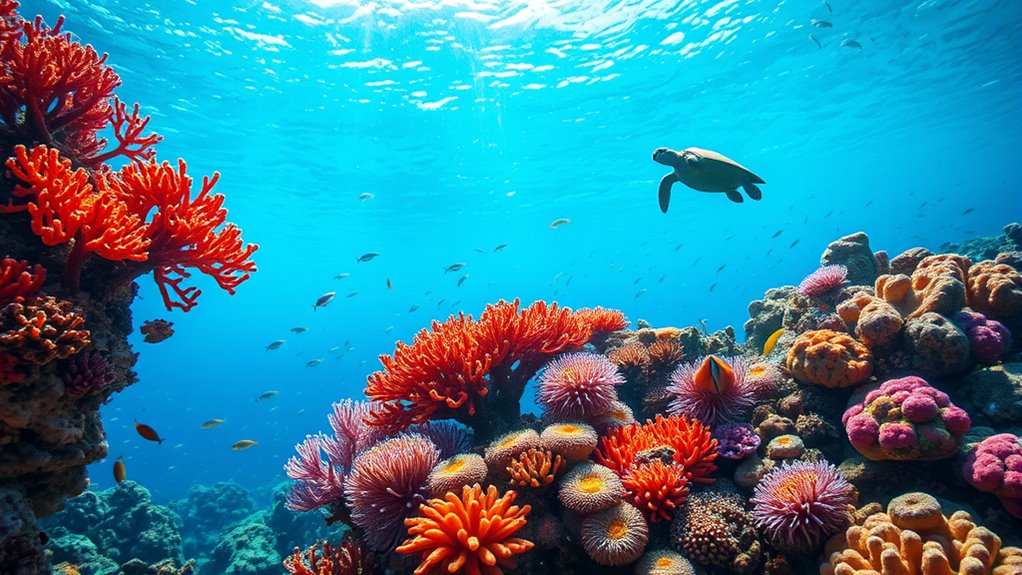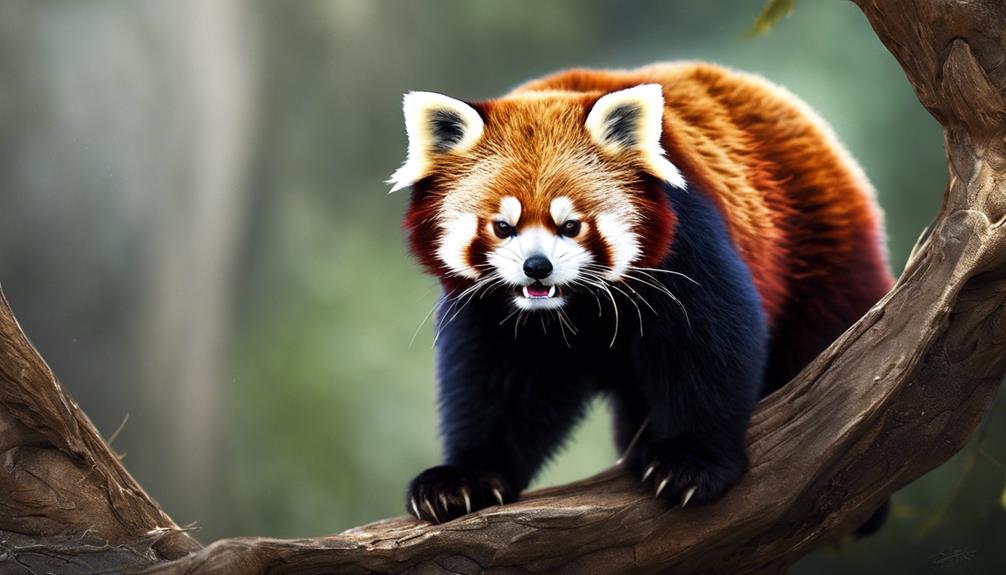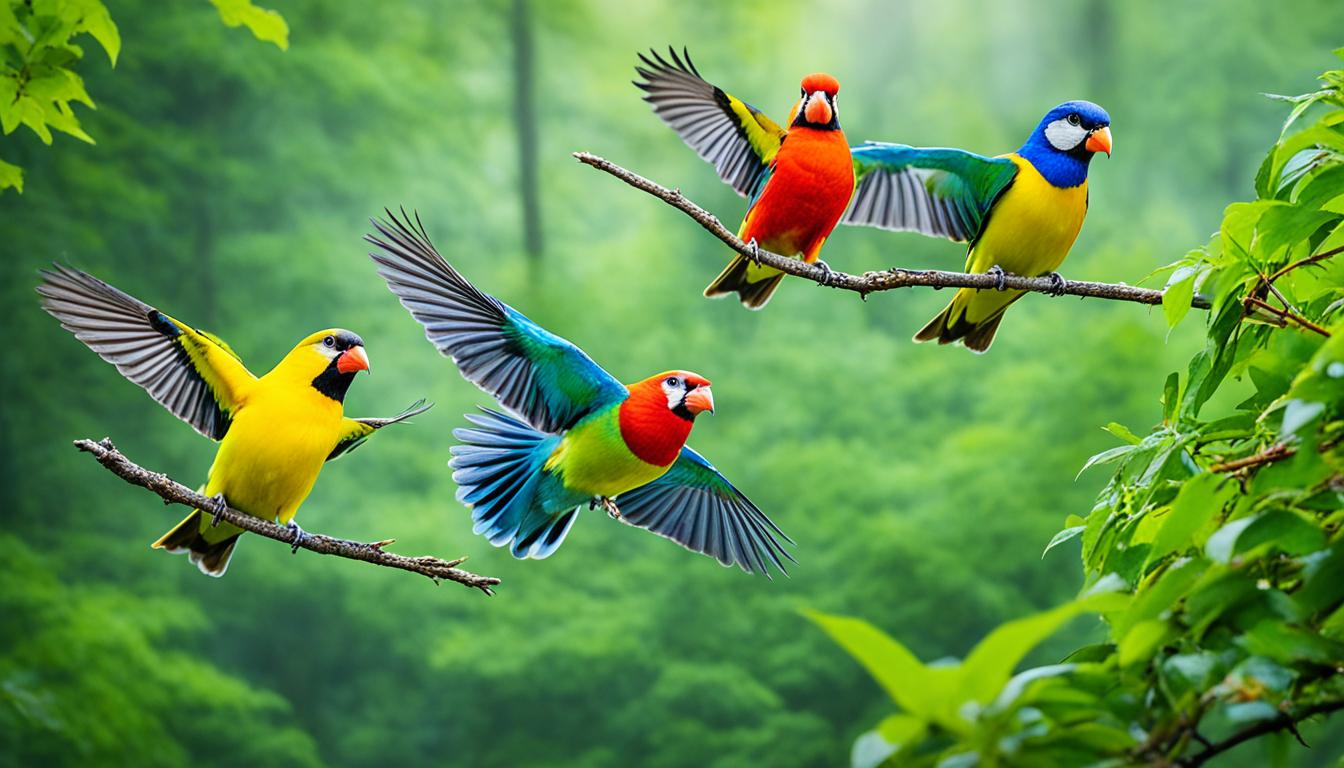A coral reef is a bustling hub of life, often called the "rainforest of the sea." You'll find numerous coral species, from hard corals that form robust structures to soft ones that add beauty to the reef. These ecosystems are home to diverse marine creatures that interact in complex ways, sharing mutual benefits. At night, corals and their neighbors engage in a dance of feeding and foraging. There's so much more to discover about these essential ecosystems and their importance to ocean health.
Key Takeaways
- Coral reefs are vital ecosystems, home to over 25% of all marine species, supporting biodiversity and ocean health.
- They are built by hard coral polyps, which create limestone structures and can reproduce both sexually and asexually.
- Coral reefs engage in nighttime activities, where polyps capture zooplankton and other creatures hunt using specialized adaptations.
- Mutualistic relationships, such as clownfish and sea anemones, enhance the resilience and interconnectedness of reef inhabitants.
- Conservation efforts are essential to protect coral reefs from threats, ensuring their survival for future generations and maintaining ocean balance.
Overview of Coral Reefs

Coral reefs, often referred to as the "rainforests of the sea," are remarkable ecosystems that play a crucial role in ocean health.
Formed over millions of years, these structures arise from the limestone produced by tiny coral polyps, each no bigger than a grain of rice.
The Great Barrier Reef, the largest in the world, stretches over 1,200 miles and showcases an incredible diversity of marine life.
You'll find two main types of coral polyps: hard coral polyps, which build the reef, and soft coral polyps, which add beauty and complexity.
These reefs provide food and shelter for more sea creatures than any other ocean habitat, highlighting their ecological significance and vibrant colors that support countless marine organisms.
Types of Coral Animals
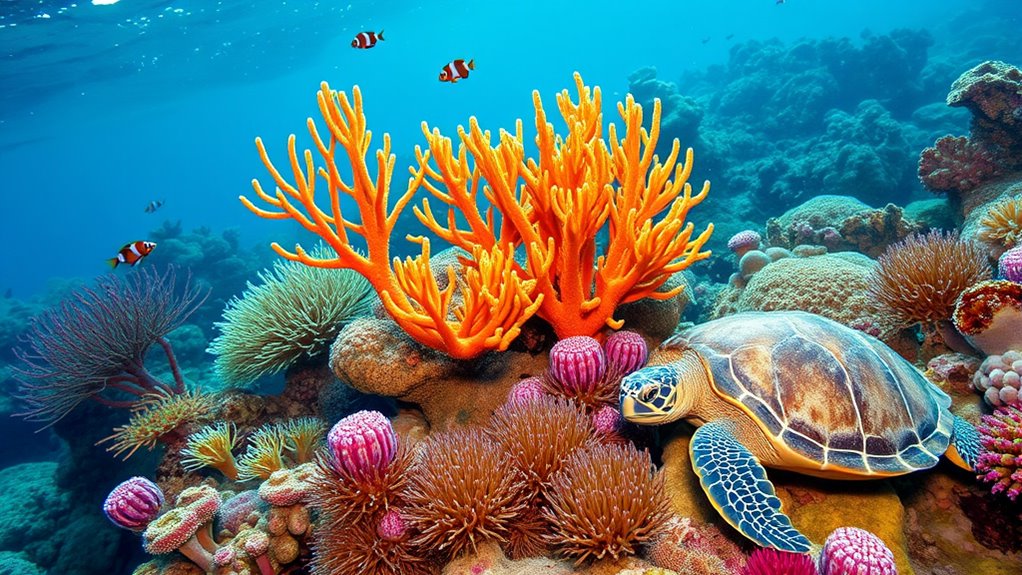
When you explore coral reefs, you'll find two main types of coral animals: hard coral polyps and soft coral polyps.
Hard corals build the reef structures you see, while soft corals add beauty and habitat without forming a solid foundation.
Understanding these two types helps you appreciate the complex ecosystem thriving beneath the waves.
Hard Coral Polyps
Hard coral polyps, the architects of vibrant underwater cities, play a crucial role in building coral reefs. These tiny creatures, about the size of a grain of rice, form colonies that take on various shapes like boulders and pillows. Through their calcium carbonate secretions, they create limestone skeletons over millions of years. You'll find hard corals thriving in shallow, warm waters, essential for coral reef ecosystems. The complex structures they create provide food and shelter for countless marine species.
| Common Types | Unique Roles |
|---|---|
| Brain Coral | Stabilizes reef structure |
| Staghorn Coral | Offers habitat for fish |
| Elkhorn Coral | Protects shorelines |
Soft Coral Polyps
While hard coral polyps dominate the construction of reef frameworks, soft coral polyps add a unique flair to the underwater landscape.
These non-reef building corals come in various shapes, resembling fans, flowers, or delicate lace, enhancing the biodiversity of coral reefs.
Unlike their hard counterparts, soft corals have a flexible structure and lack a rigid calcium carbonate skeleton, allowing them to sway gracefully with ocean currents.
They play a vital role in the reef ecosystem by providing habitat and shelter for numerous marine species, which boosts the overall health of the reef.
Additionally, many soft coral species produce toxins, deterring predators and making them less palatable to herbivores.
Their vibrant colors and unique forms also attract divers and researchers alike.
Interactions Among Reef Creatures
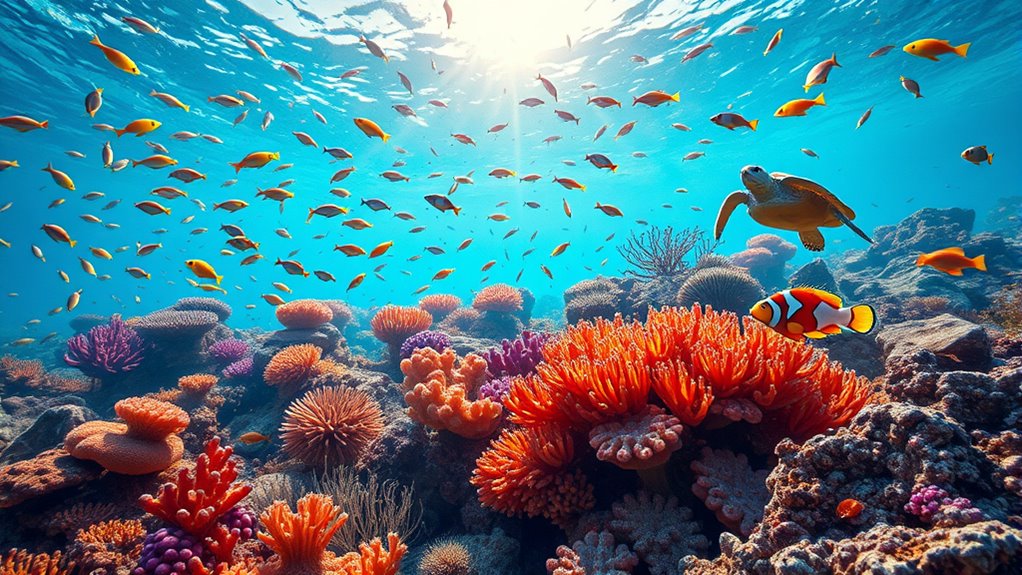
Coral reefs thrive on the intricate interactions among their diverse inhabitants, showcasing a rich tapestry of relationships that enhance survival.
You'd discover mutualistic partnerships, like goby fish cleaning larger predators such as groupers and moray eels. Clownfish find safety in sea anemones while keeping them clean.
The reef's delicate balance relies on camouflage, where creatures like decorator crabs blend seamlessly into their surroundings. At night, various species hide from predators, ensuring their safety.
- Goby fish and groupers share a cleaning bond
- Clownfish protect sea anemones while benefiting from them
- Decorator crabs use materials to camouflage
- Scorpion fish hunt while others seek refuge at night
These interactions create a dynamic and vibrant ecosystem.
Coral Reproduction and Growth
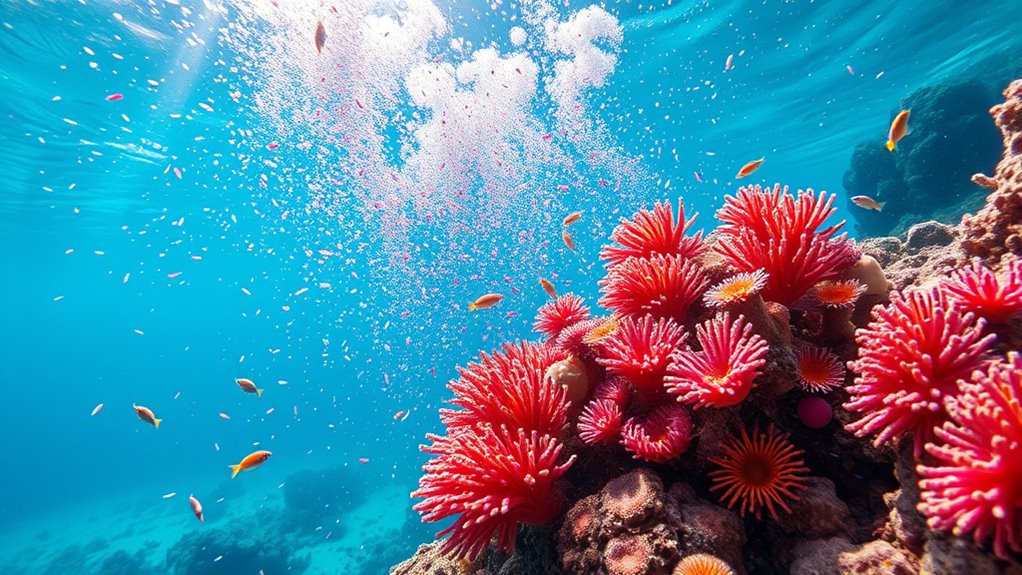
As you explore the fascinating world of coral reproduction and growth, you'll find that coral polyps have unique ways of ensuring their survival. They release egg bundles into the water during full moons, which hatch into larvae that eventually settle on hard surfaces and mature into adult polyps.
In addition to sexual reproduction, coral polyps can reproduce asexually through budding, where new polyps grow directly from the parent. Over millions of years, the growth of coral reefs occurs as layers of old polyps accumulate, forming limestone structures that support new coral.
The vibrant colors of coral polyps not only captivate your eye but also play an essential role in attracting mates and aiding in their reproductive success.
Nighttime Activities of Reef Inhabitants
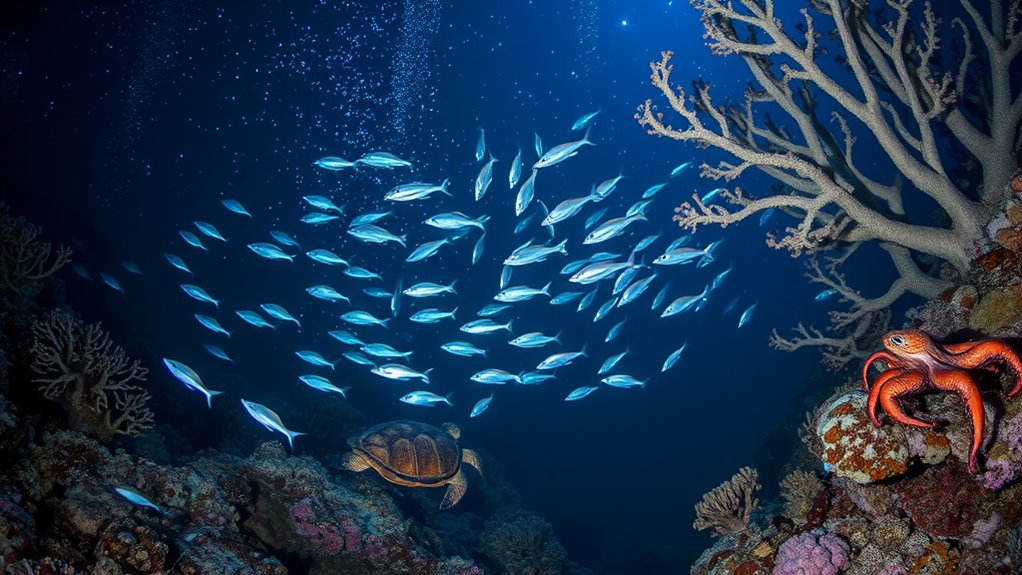
As night falls over the coral reef, you'll notice the bustling activity of its inhabitants.
Coral polyps stretch their tentacles to capture zooplankton, while eels and spiny lobsters hunt for their next meal in the shadows.
These nighttime behaviors reveal a vibrant ecosystem that's alive even when the sun goes down.
Coral Polyps' Night Feeding
When night falls over the reef, coral polyps spring into action, capturing zooplankton with their tentacles as they take advantage of the increased prey availability.
The reef transforms into a vibrant ecosystem where you can witness:
- Flashlight fish blinking their light pouches, luring in unsuspecting zooplankton.
- The graceful retraction of coral polyps' tentacles, conserving energy for the next feeding frenzy.
- Spiny lobsters and octopuses hunting with heightened senses, seeking out their next meal.
- The magical moment when coral polyps release egg bundles during the full moon, initiating new life.
As darkness descends, you'll see the reef bustling with activity, showcasing the intricate dance of survival among its inhabitants.
Eel and Lobster Hunting
With the coral polyps busy capturing their nighttime meals, other inhabitants of the reef are also on the prowl.
Eels glide silently through the water, relying on their keen sense of smell to hunt down unsuspecting fish. Their colorless liquid covering helps them blend into the surroundings, allowing for stealthy ambushes.
Meanwhile, spiny lobsters explore the sandy bottom, using both smell and touch to locate their preferred snacks like clams, mussels, and snails.
As night falls, these nocturnal hunters showcase their adaptive behaviors, maneuvering through the reef's intricate ecosystem.
The dynamic interactions between eels, lobsters, and other species highlight how every creature has its own strategy for survival, ensuring the coral reef thrives even after the sun sets.
Feeding Mechanisms of Coral Polyps

Coral polyps employ fascinating feeding mechanisms to thrive in their underwater habitats. These tiny creatures use their specialized tentacles to capture zooplankton and other small particles, making the most of their environment. Here's how they do it:
- Their tentacles are lined with stinging cells called nematocysts, which immobilize prey.
- At night, they extend these tentacles, reaching out for plankton in the dark waters.
- They harness nutrients from symbiotic zooxanthellae, the algae living within their tissues.
- Their feeding rhythm often aligns with lunar cycles, peaking during full moons when they release egg bundles.
During the day, coral polyps wisely retract their tentacles to conserve energy and shield themselves from harmful UV rays.
Communication Strategies in the Reef
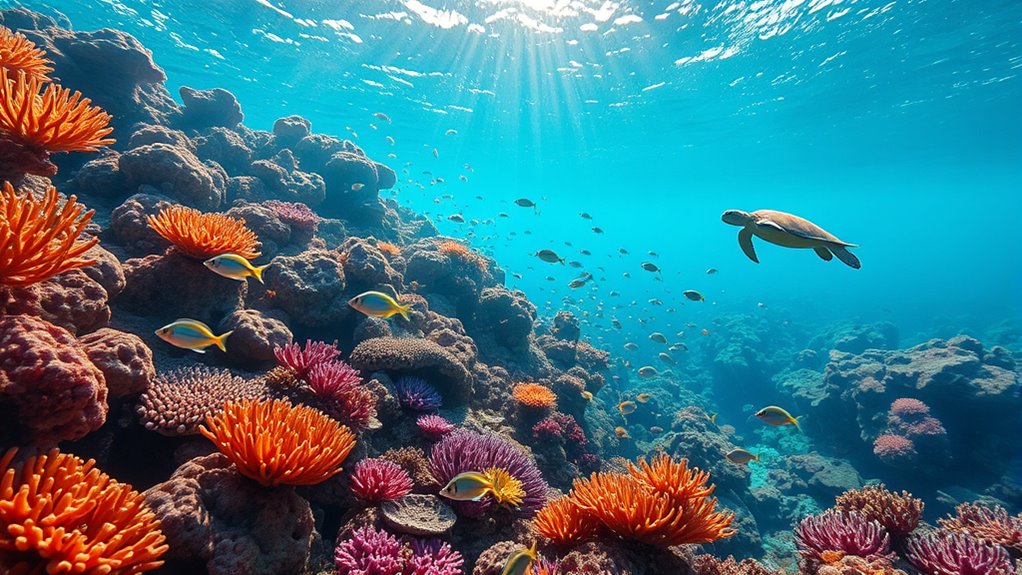
Life in the reef isn't just about feeding; it's also about communication. Flashlight fish use blinking lights from pouches under their eyes to attract zooplankton and coordinate activities.
Eels rely on their keen sense of smell, enhancing their hunting efficiency and navigation.
Eels enhance their hunting and navigation skills through their exceptional sense of smell, crucial for survival in the reef.
Parrot fish cover themselves with a colorless liquid for camouflage, helping them evade predators while resting.
Spiny lobsters utilize touch to interact with their surroundings, aiding in food location and navigation through the reef structure.
Coral polyps respond to light and darkness cues, retracting their tentacles during the day to conserve energy and extending them at night to capture zooplankton.
These diverse communication strategies are essential for survival in the vibrant ecosystem of the reef.
The Importance of Coral Reefs for Ocean Health
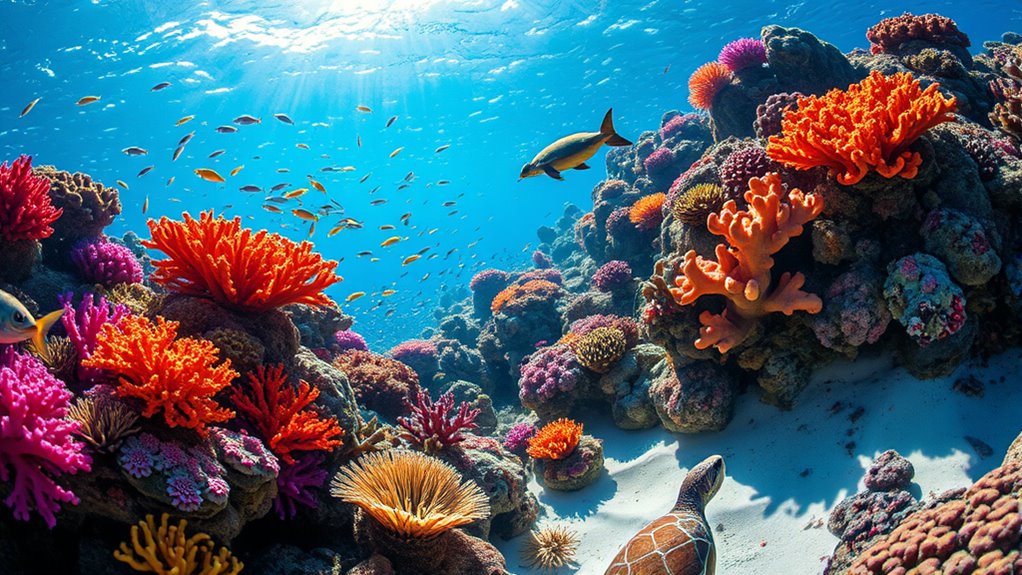
Although you may not realize it, coral reefs are crucial to ocean health, serving as the foundation for diverse marine ecosystems. These vibrant underwater structures support countless species and contribute markedly to global stability.
Here's why coral reefs matter:
- They provide critical habitat for over 25% of all marine species, enhancing biodiversity.
- Acting as natural barriers, they protect coastlines from erosion and storm surges.
- Coral reefs boost local economies through tourism, fishing, and seafood production, generating billions annually.
- They play an important role in carbon cycling, sequestering carbon dioxide and helping mitigate climate change.
Protecting coral reefs guarantees a healthier ocean for future generations, sustaining life above and below the surface.
Frequently Asked Questions
What Is Life Like in a Coral Reef?
Life in a coral reef's bustling ecosystem is vibrant and full of activity.
You'll see colorful fish darting between coral structures, while larger predators lurk nearby. The reef's inhabitants interact in fascinating ways, like clownfish finding safety in anemones.
As night falls, creatures adapt their behaviors; some hunt, while others hide.
You'll witness the beauty of reproduction as coral polyps release eggs, ensuring the continuation of this dynamic underwater world.
What Is the Life Cycle of a Coral Reef?
Did you know that coral reefs support about 25% of all marine species?
The life cycle of a coral reef starts when coral polyps release egg bundles into the water, typically during full moons.
Once the larvae hatch, they settle on hard surfaces, maturing into adult polyps.
These polyps can reproduce both sexually and asexually, continuously contributing to the reef's growth and the vibrant ecosystem that thrives within it.
What Is the Lifespan of a Coral Reef?
The lifespan of a coral reef can stretch for thousands of years, with some, like the Great Barrier Reef, being over 20,000 years old.
Individual coral polyps live around 5 to 10 years, but they constantly bud and create new polyps, which helps the reef persist.
However, environmental factors and human impacts threaten their longevity.
If you focus on conservation, you can help guarantee these ecosystems thrive for future generations.
What Is the Life Form of a Coral?
You know what they say: "Good things come in small packages." Coral polyps are those tiny marvels, each about the size of a grain of rice.
These remarkable sea creatures form colonies, building intricate reefs by secreting limestone. They thrive at night, capturing zooplankton for food, while conserving energy during the day.
Reproducing through both egg release and budding, these polyps guarantee the continuation of their vibrant underwater world.
Isn't nature fascinating?
Conclusion
In exploring the vibrant life of a coral reef, you've seen the intricate relationships, the stunning diversity, and the essential roles these ecosystems play. You've witnessed the beauty of coral reproduction, the nightly gatherings of reef inhabitants, and the unique feeding mechanisms at work. By understanding and appreciating coral reefs, you're not just admiring their splendor; you're recognizing their significance, advocating for their protection, and ensuring their survival for generations to come. Let's cherish and safeguard these underwater treasures together.
